If you miss being able to slice into a log of cheese and spread it on bread or crackers, this fermented cashew cheese will give you back that experience.
And if you’ve ever been disappointed by the vegan cheese options at the grocery store or don’t have access to them, this recipe will be a godsend.
First, a simple mixture of cashews, vinegar, lemon juice, coconut oil, nutritional yeast, and seasonings gets blended until smooth. Then, it ferments for a day or two. Finally, the cheese gets shaped into a log (think a log of goat cheese) and hangs out in the fridge for a few hours. Once sliced, it’s easy to slice and spread (and is SO very tasty).
Hungry for even more vegan cheese?
Check out my complete guide to vegan cheese! It covers the best vegan cheese recipes to use for every situation (like Vegan Feta and Vegan Queso) and reviews the best vegan cheeses you can buy at the supermarket.
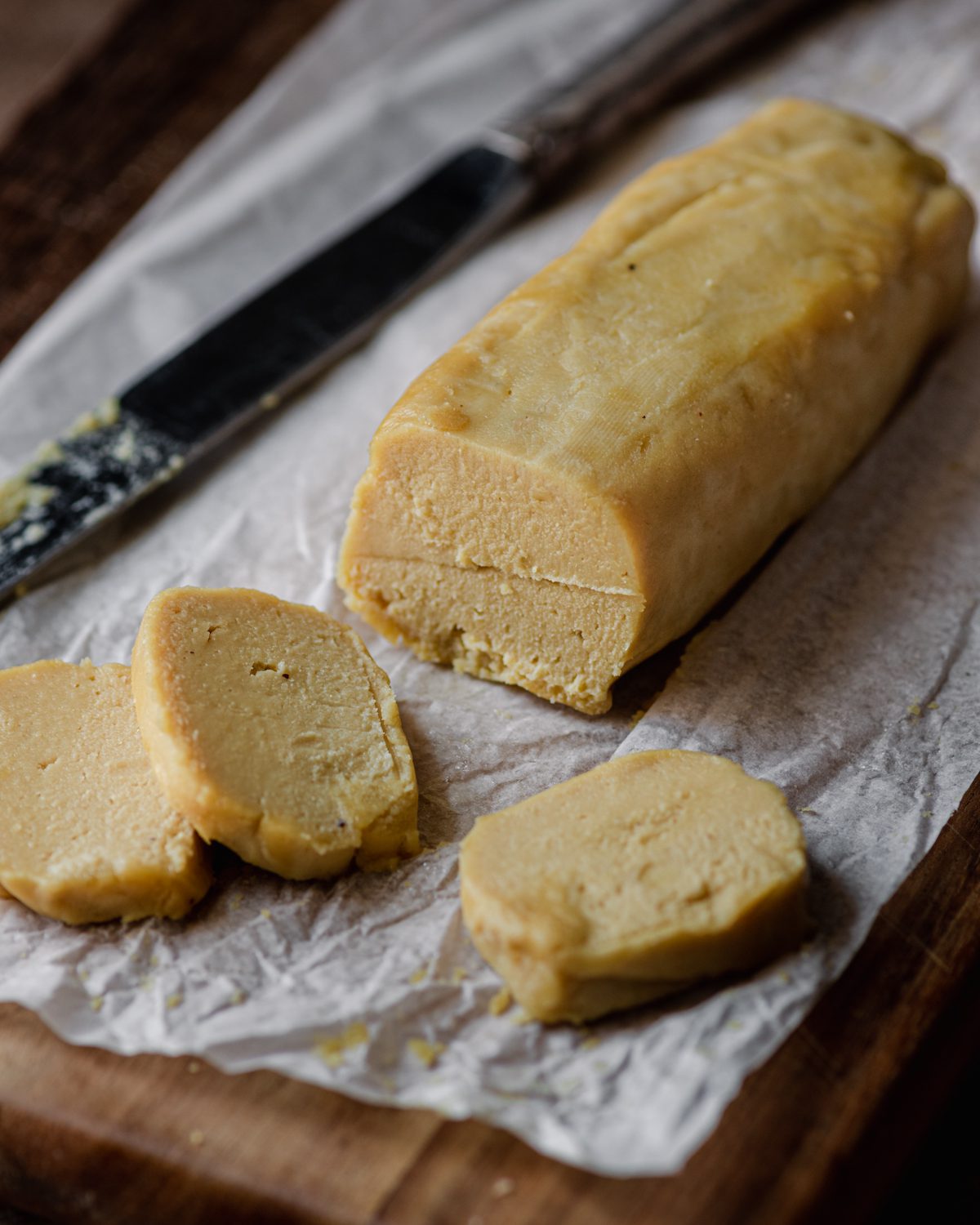
Why you’ll love this recipe
Sliceable and spreadable. Homemade vegan cheese recipes that are sliceable and/or spreadable are hard to come by, and if you don’t have access to vegan cheeses at your grocery store, this is an amazing option to keep in your fridge. The addition of coconut oil and very little liquid makes the cheese solid enough to hold its shape and to slice.
Easy and minimal ingredients. This recipe requires just 10 to 15 minutes of hands-on work and a bit of patience while the cheese ferments. And just 7 pantry-friendly ingredients!
Gourmet and flavorful. Despite being so easy to make, this cheese feels fancier than most homemade cheeses and is packed with flavor. In addition to having subtle cheesy vibes from nutritional yeast, it has so much more tanginess and umami than your standard vegan cheese thanks to fermentation.
Make ahead. Because this is a fermented cheese, it will continue to stay good in your fridge for several weeks… if you can resist eating it!
Wholesome but indulgent. Fermented cashew cheese has all the traditional dairy cheese flavors but it’s made with wholesome plant-based ingredients. Plus, the live bacteria created in the fermentation process are good for your gut!
If you’re interested in some of the crazy cool things cashews can do to recreate your favorite comfort foods, check out my crazy good Vegan Spinach Artichoke Dip or Vegan Moussaka!
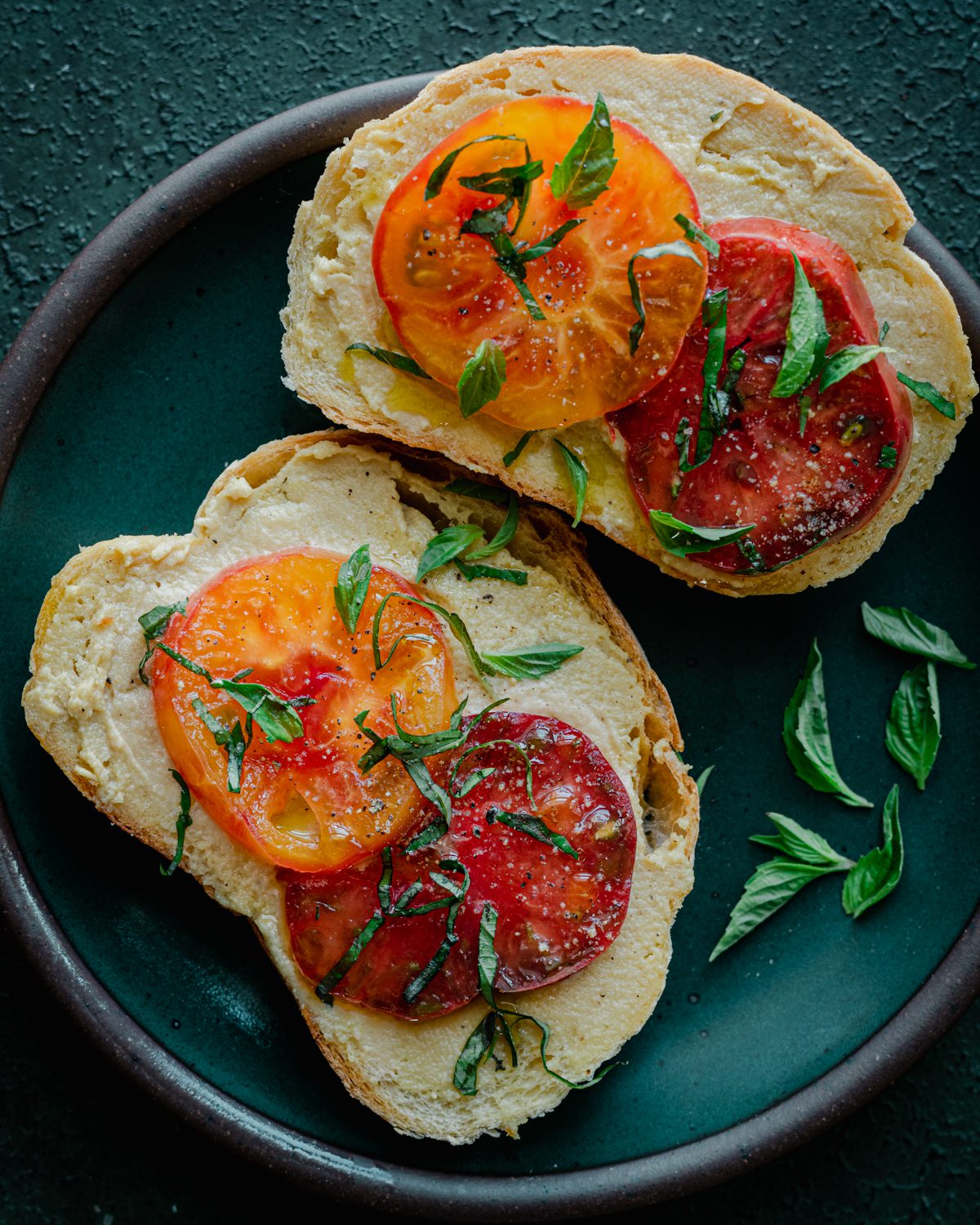
How to make this recipe
Add the soaked cashews, apple cider vinegar, lemon juice, and coconut oil to a high-powered blender. Blend on medium to high speed for several minutes, scraping down the sides of the blender several times as you go, until relatively smooth.
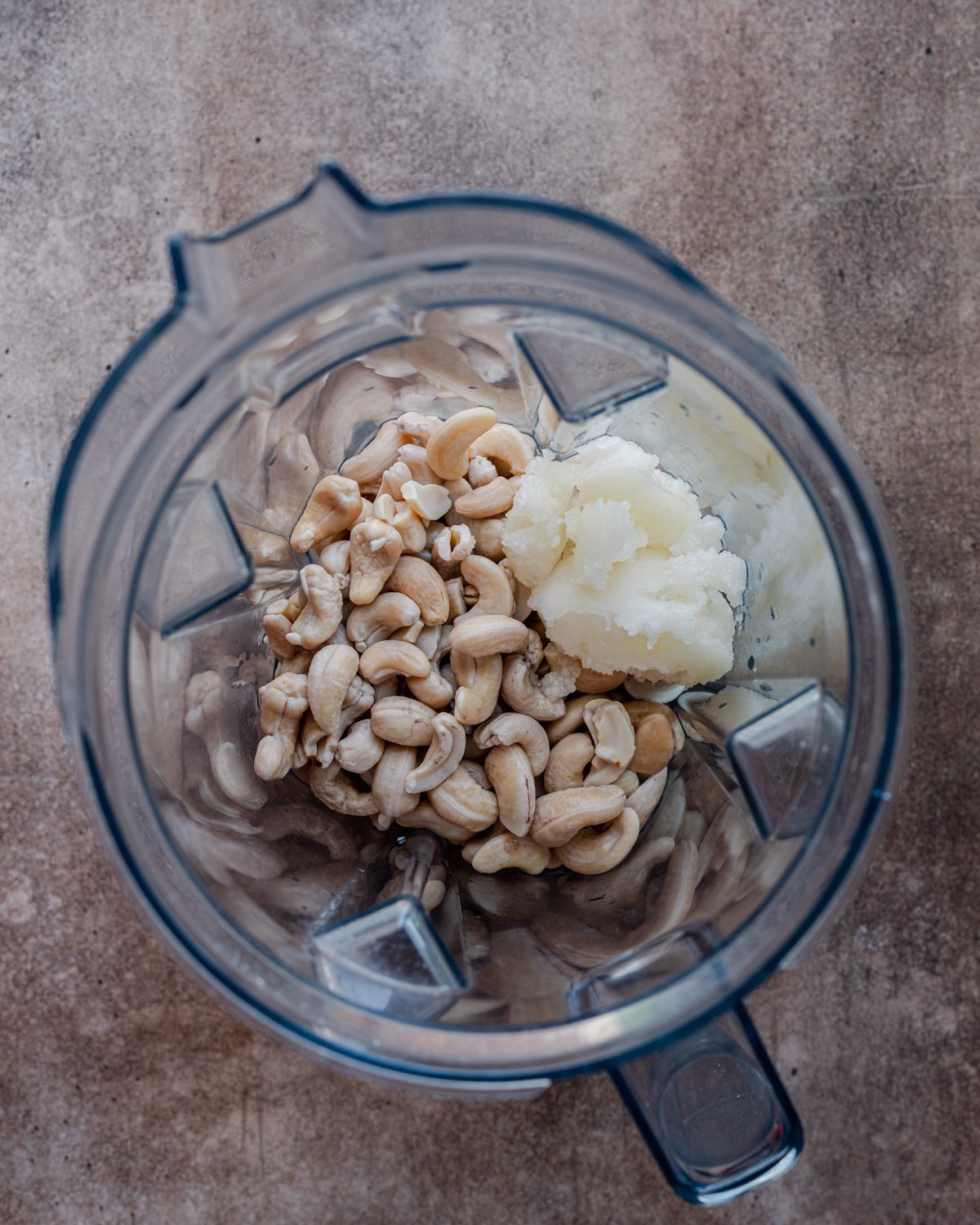
Add the nutritional yeast, garlic powder, onion powder, and salt. Blend again until completely smooth.
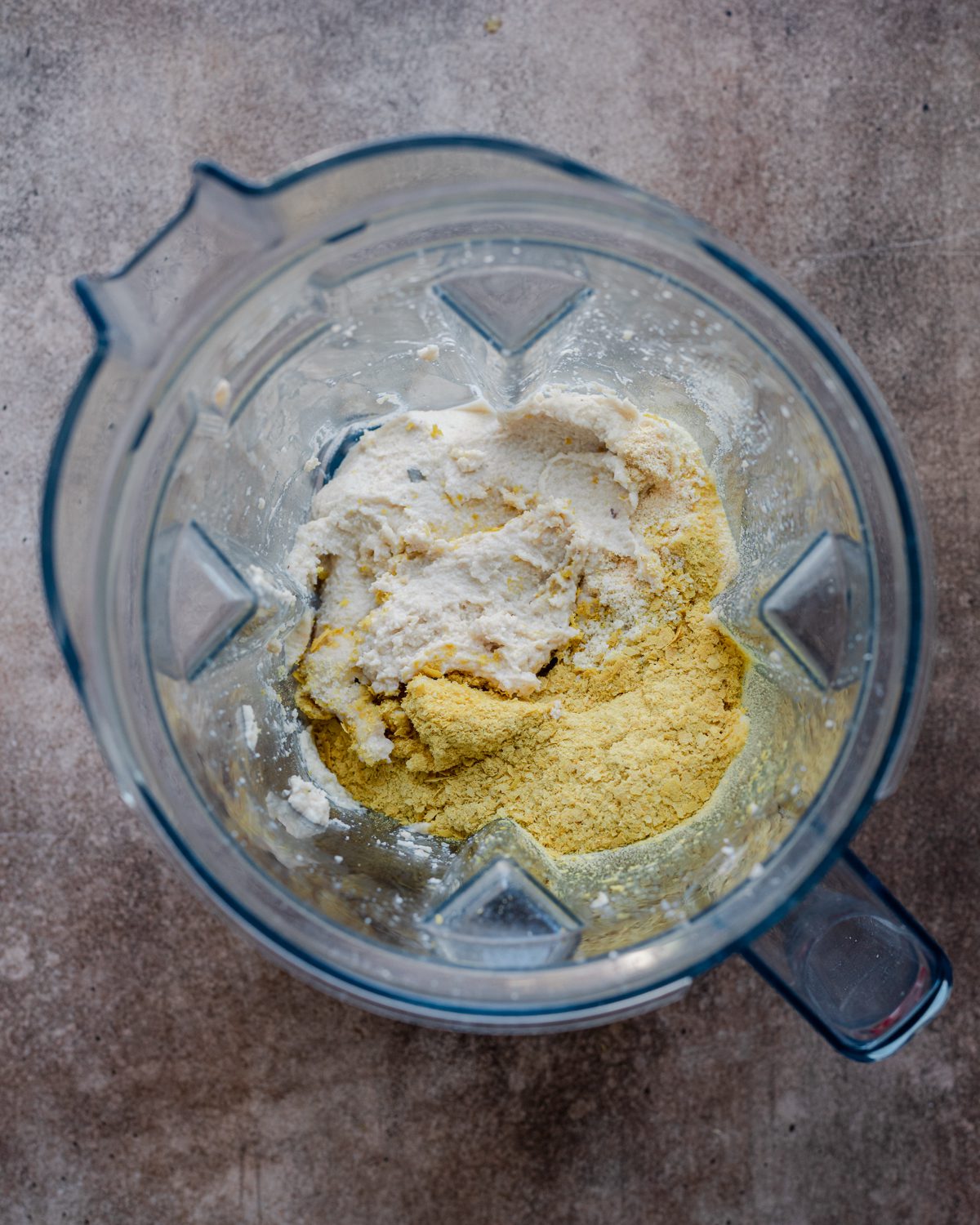
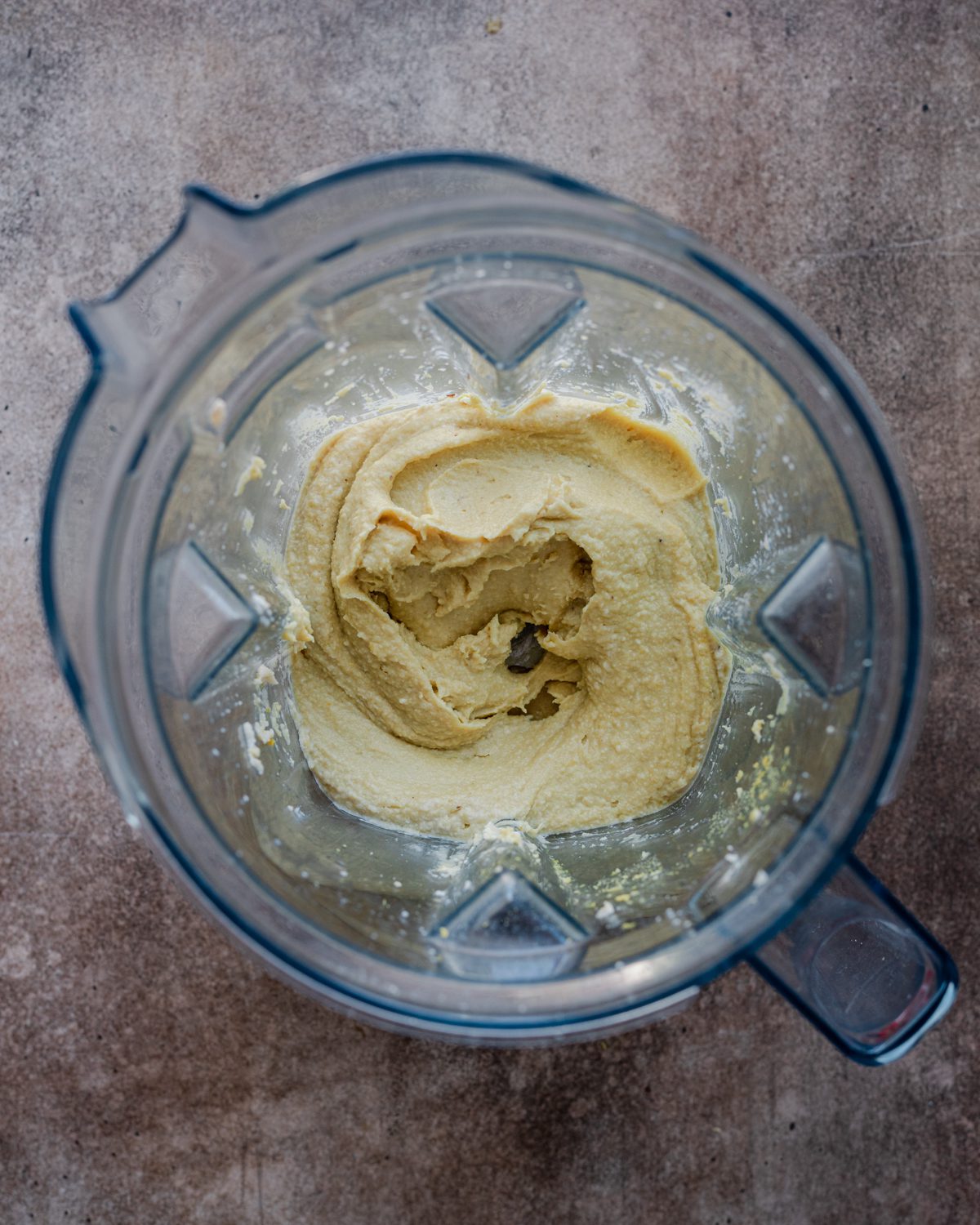
Transfer the cheese mixture to a clean mason jar (you can sterilize it if desired but it’s not necessary). Seal the jar and place in a warm spot to ferment for at least 16 hours, or up to 48 hours. (see “Tips” section for fermentation tips).
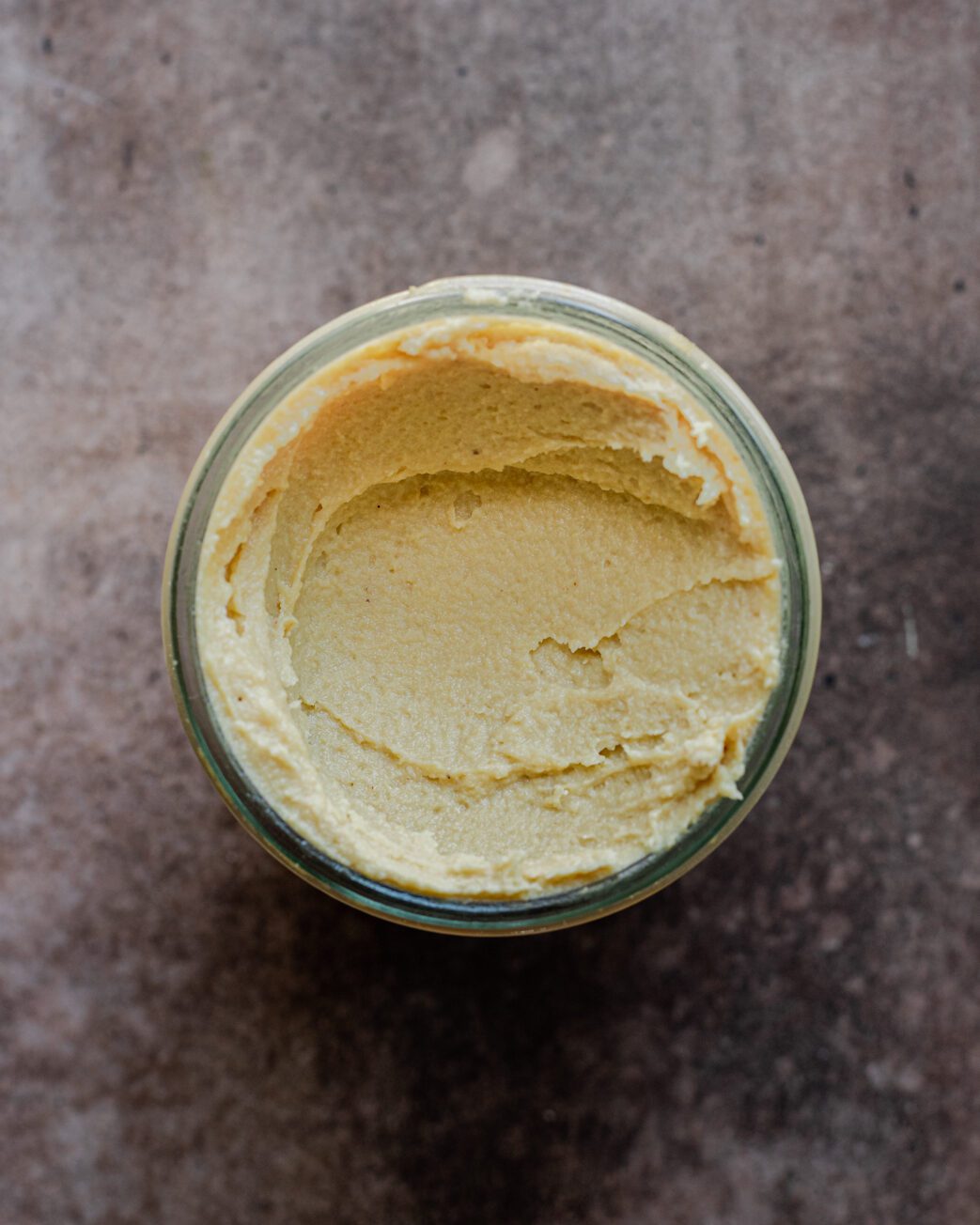
Stir the fermented cheese and transfer to the fridge for at least 4 hours to set.
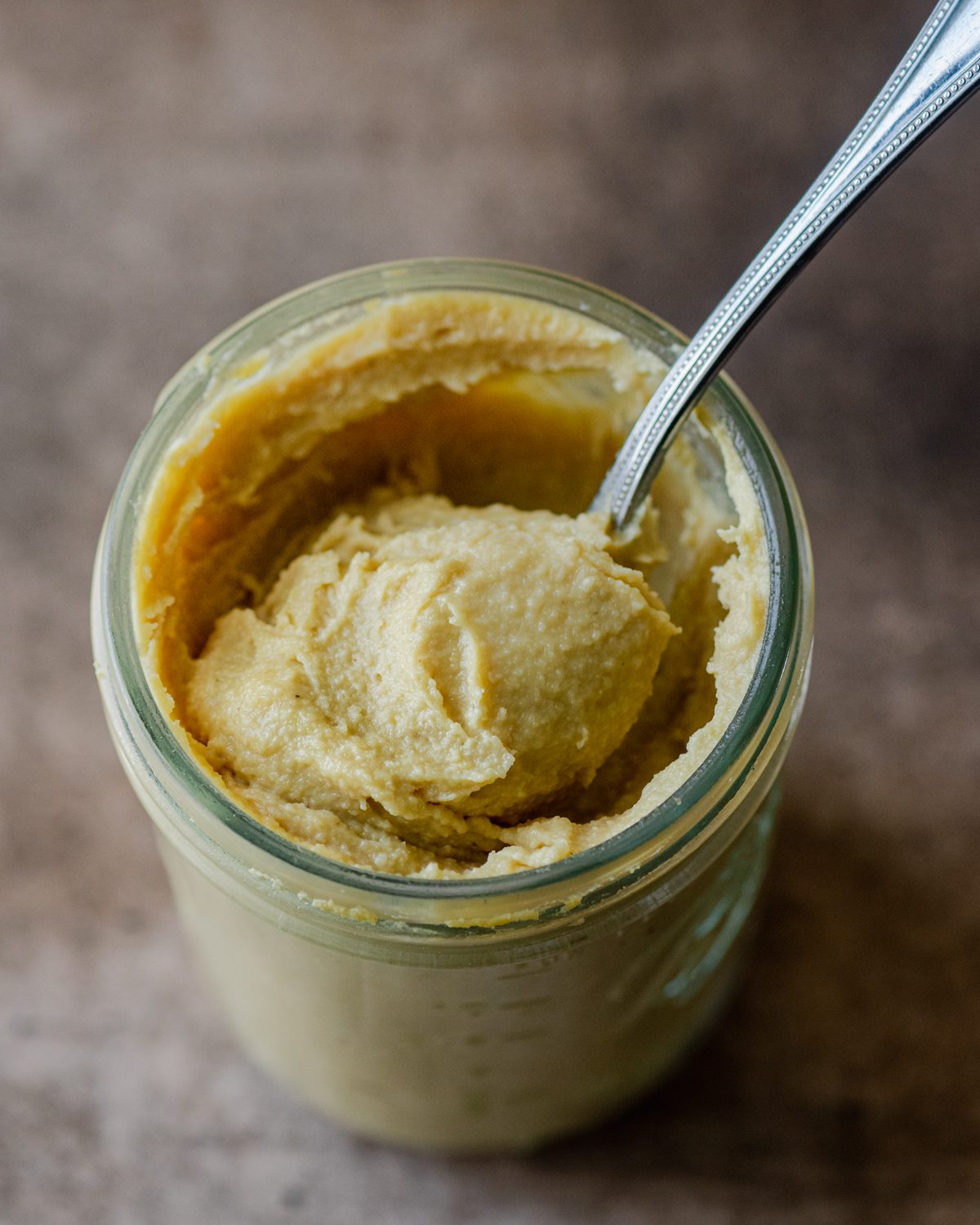
Once the cheese has solidified, scoop out half of it onto a sheet of parchment paper. Use a spoon to push it into a log-like shape.
Roll up the parchment paper and your hands to mold and shape the cheese into a log shape. Repeat with the other half of the cheese. Refrigerate the cheese logs for 2 hours, or more, to set.
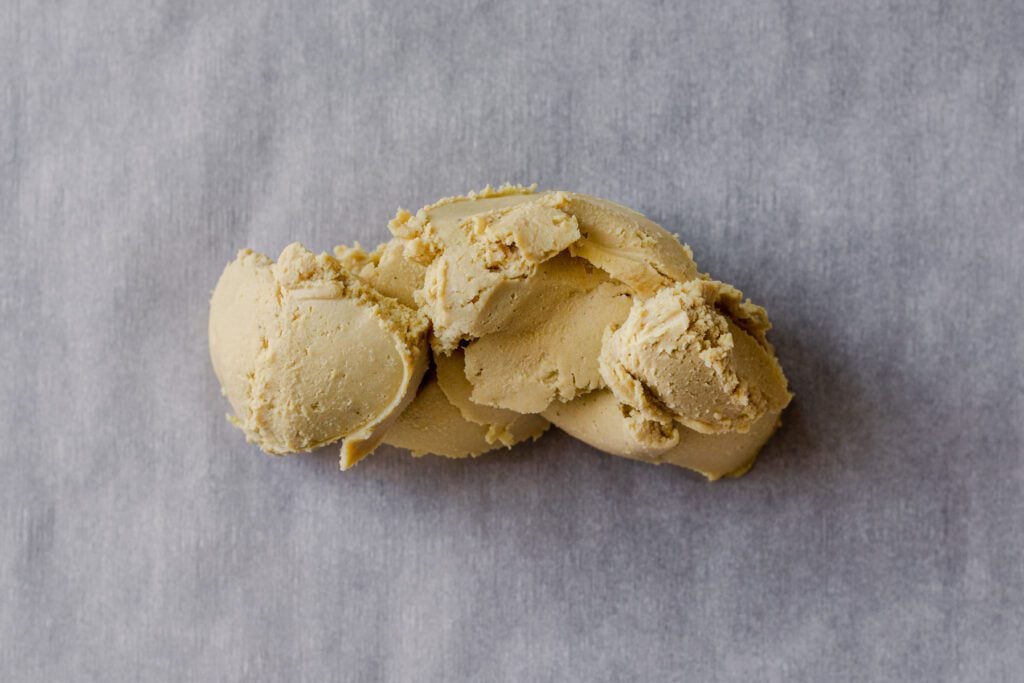
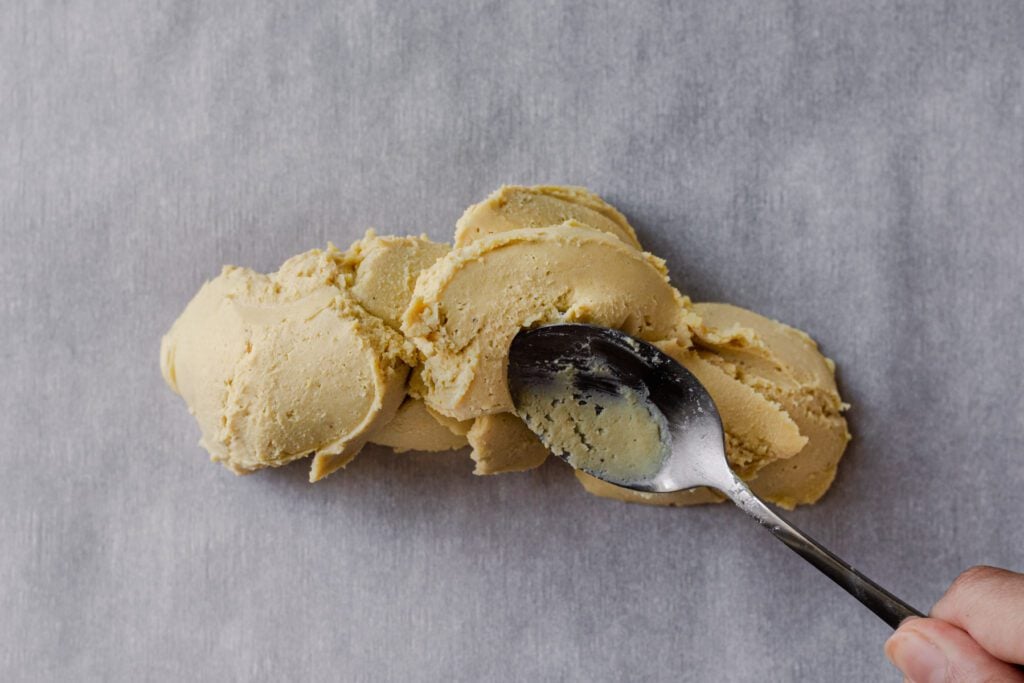
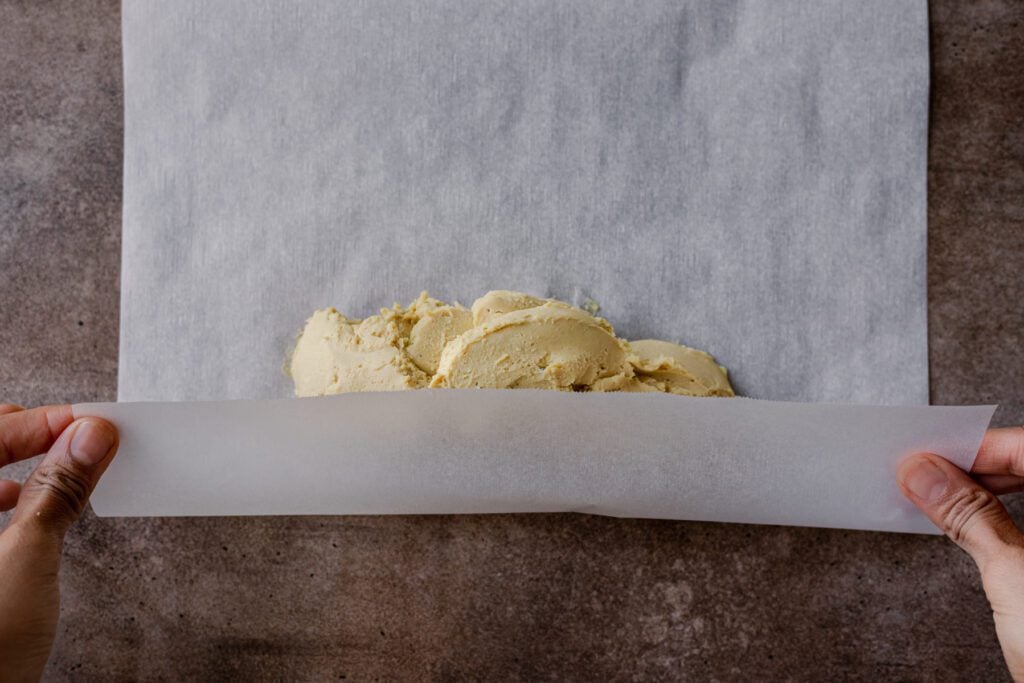
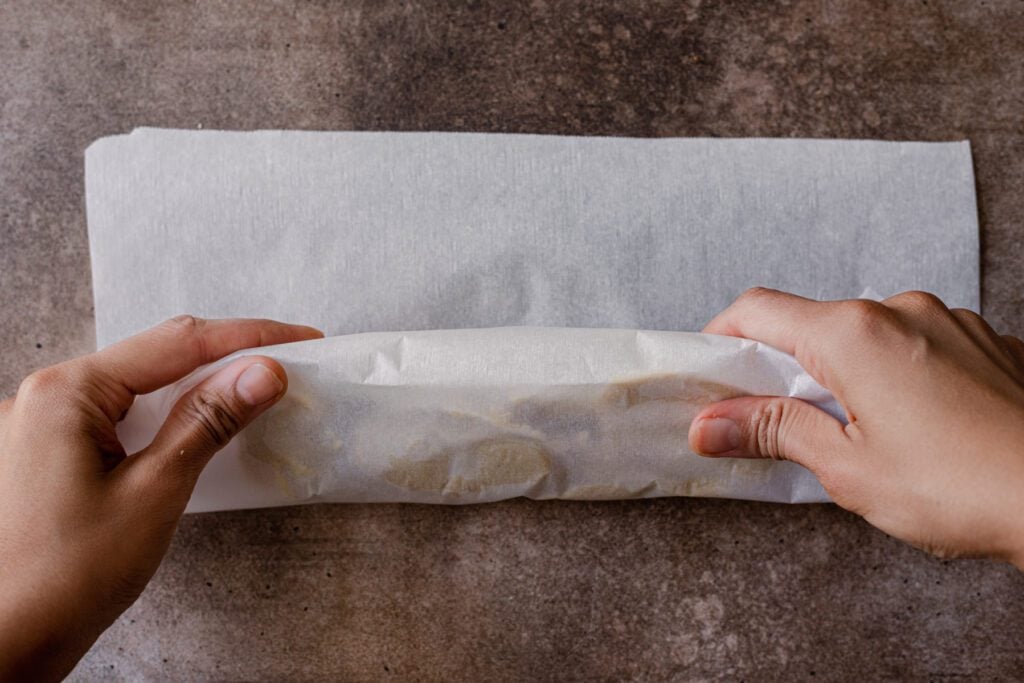
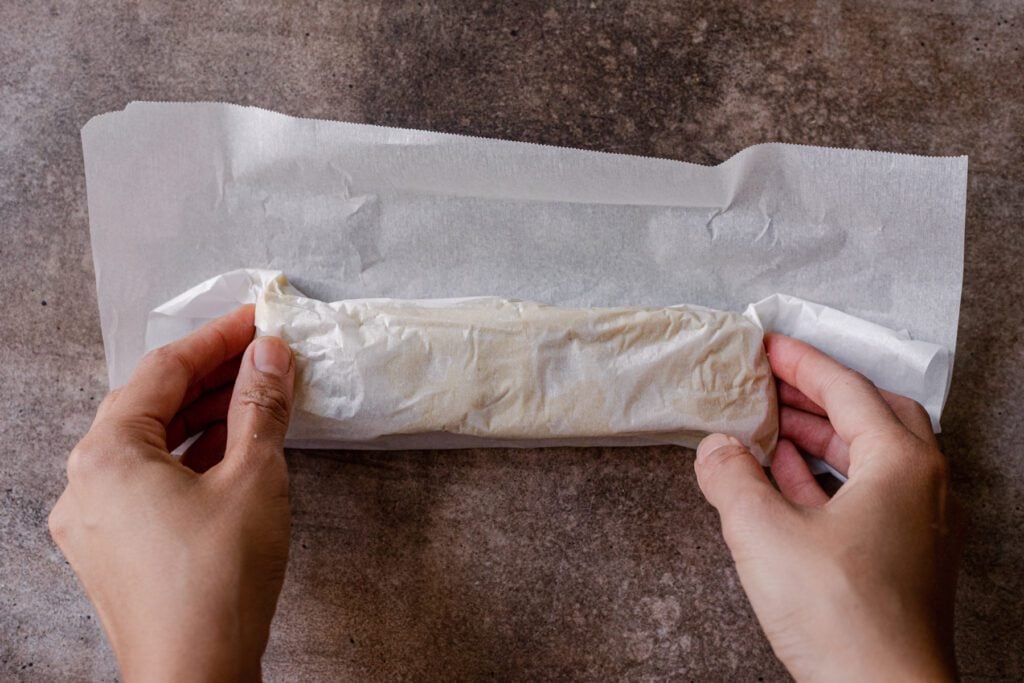
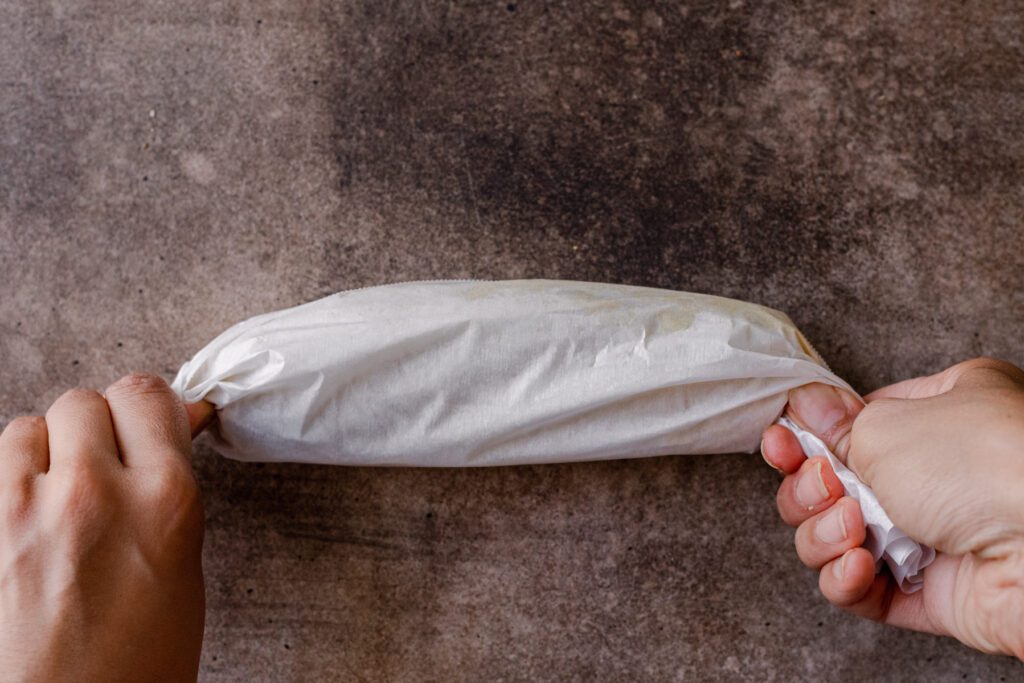
Once the cheese log is set, slice and spread as desired.
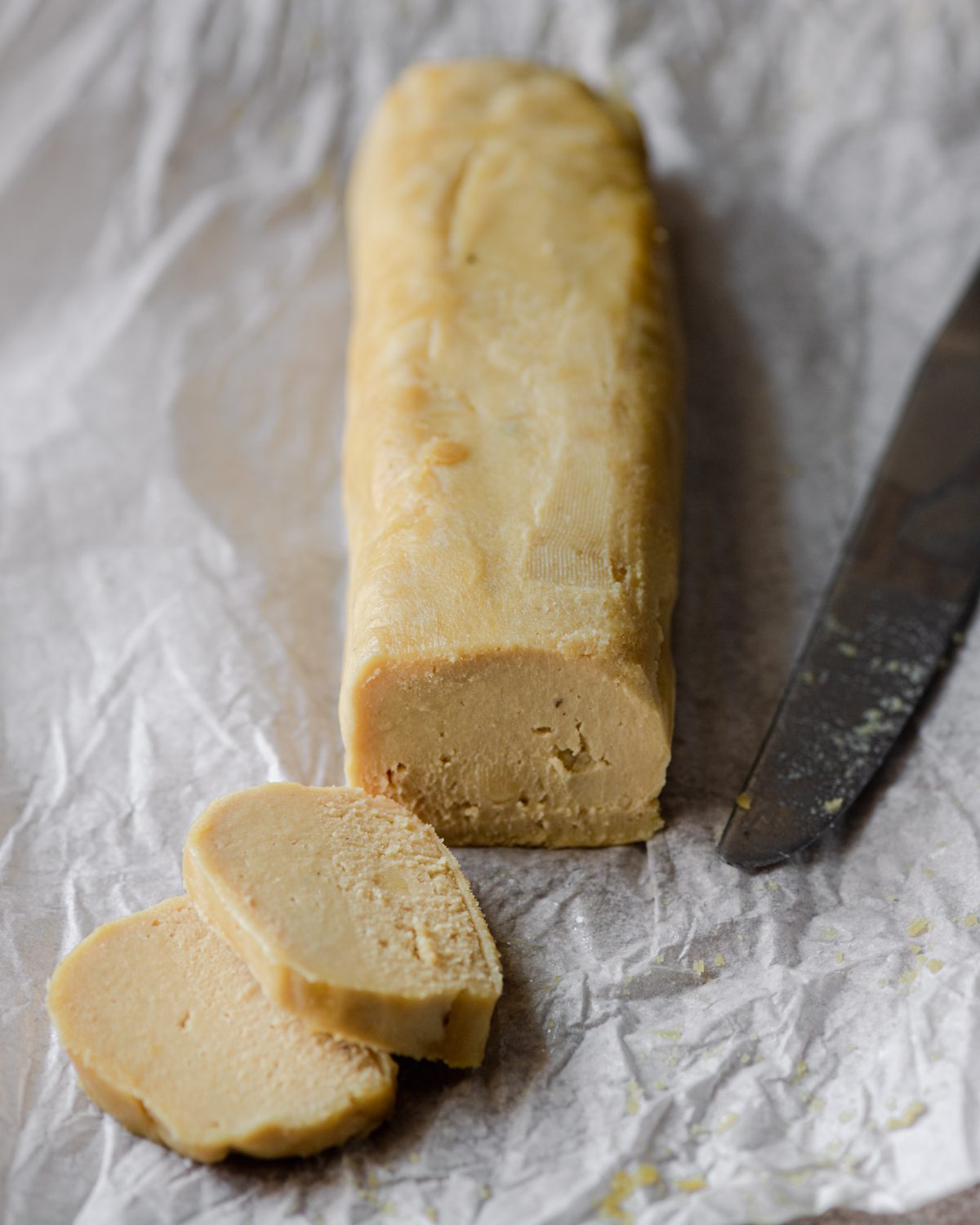
Tips for making this cheese
How to soften raw cashews.
I highly recommend soaking your cashews in cool water overnight, or boiling them on the stove for 20 minutes. Since there’s very little liquid, a proper soak or boil is necessary to fully soften the cashews.
Use a clean glass jar.
Wash your jar and lid with soapy warm water and dry well before adding your cheese and fermenting.
Use a high-powered blender.
Along the same lines, you’ll get the best, smoothest results with a high-powered blender, as you want a powerful machine to fully pulverize the cashews. Since there’s not much liquid, you’ll need to scrape down the sides several times as you go, especially if you have a large-sized blender container like me (I have the 64-ounce Vitamix container; it’s considerably easier with a smaller blender container).
Shake the apple cider vinegar.
It’s important to include a bit of the “mother” bacteria from the vinegar to start the fermentation process. Shaking the apple cider vinegar before pouring it ensures that the mother bacteria is evenly distributed.
Let it come to room temperature
If your cheese log has been in the fridge for quite awhile, let it sit at room temperature for 5 minutes to soften up. This will make it much easier to spread.
Where and how long to ferment the cheese.
One of the most important parts in the process is letting the cheese ferment in a warm place.
If it’s summertime, this could be your kitchen counter or pantry. If you live in a warm but not crazy hot climate like I do (Southern California), you can also ferment the cheese outside. Just make sure to not expose the jar to direct sunlight. I typically wrap the jar in ad dish towel during the day and set it outside; in the evening, I transfer it to the oven with the light bulb on (the warmth from the light is sufficiently warm for fermentation).
If it’s wintertime, you can just leave it in the oven as mentioned above. If that’s not an option, you’ll need to leave it out on a counter or in the pantry for at least a few days.
The warmer the temperature, the less time you should ferment it. The countertop when it’s not summer will take more time than in the oven with the light on. If the temperatuer is quite warm, consider fermenting for just 16 to 24 hours to avoid over-fermenting.
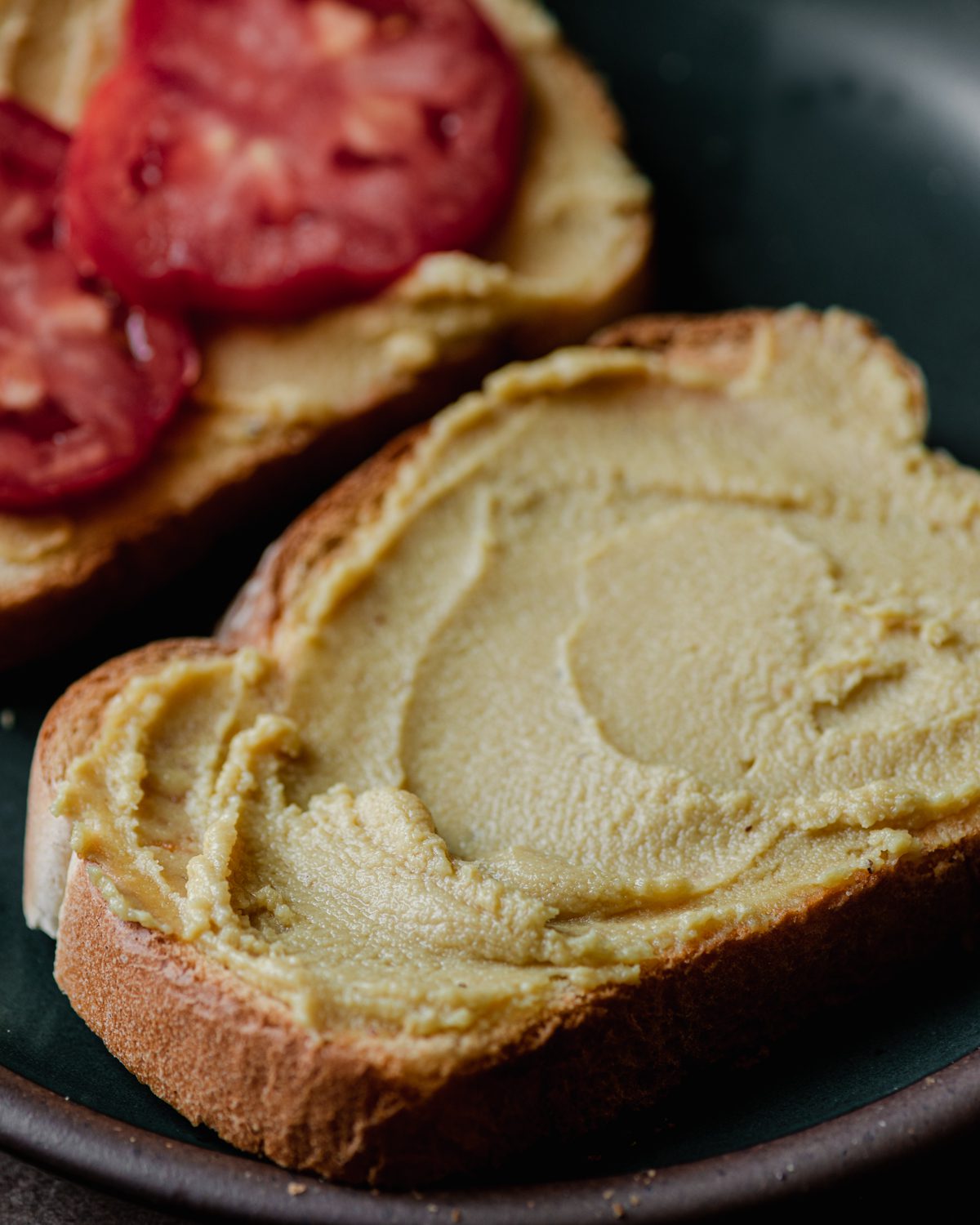
Frequently Asked Questions
The coconut oil is key for the texture of this cheese. As you might know, coconut oil has a high melting point compared to other oils (that’s why it’s solid at room temperature instead of liquid, like other oils). So when you refrigerate the cheese mixture, the coconut oil helps solidify it, leaving you with that sliceable texture.
If you are strictly oil-free, try my other oil-free cheese options (Vegan Queso and Nut-Free Cheese Sauce). If you are allergic to coconut products, you can try using olive oil, but I don’t know if you’ll get the same sliceable texture, as coconut oil is solid at room temperature.
NO! The combination of fresh garlic and oil at room temperature for more than a few hours can foster the growth of clostridium botulinum bacteria (aka botulism). It’s toxic and can cause bad severe food poisoning!
Roll it tightly in the parchment paper and store it in the fridge for at least 2 weeks. If the paper isn’t wrapped tightly, the edges dry out, so to avoid this, store the wrapped cheese in an airtight container.
Yes! Some flavor ideas are below. Just sprinkle them on after you’ve rolled the log and it’s hardened a bit. Use your hands to pat the mix-ins into the cheese. Then refrigerate again for 2 hours (or longer) to set.
– Sundried tomatoes + dried oregano
– Chopped dill + parsley
– Dried cranberries + crushed walnuts
– Pomegranate seeds + crushed pecans
How to use this cashew cheese
I have no doubt you’ll find countless uses for this delightful cheese, but here are a few to get you started:
- Spread it onto bread! My current favorite is a good crusty bread, a thick layer of fermented cheese, and heirloom tomatoes sprinkled with sea salt and pepper.
- Add some to a bowl as a dip for crudités or spread for crackers.
- Serve as part of a vegan charcuterie or cheese board with crackers, olives, and fruit.
- Use as a sandwich spread instead of mayo.
- Spread onto a pita round or flatbread and add your favorite toppings and bake in the oven for an easy pizza!
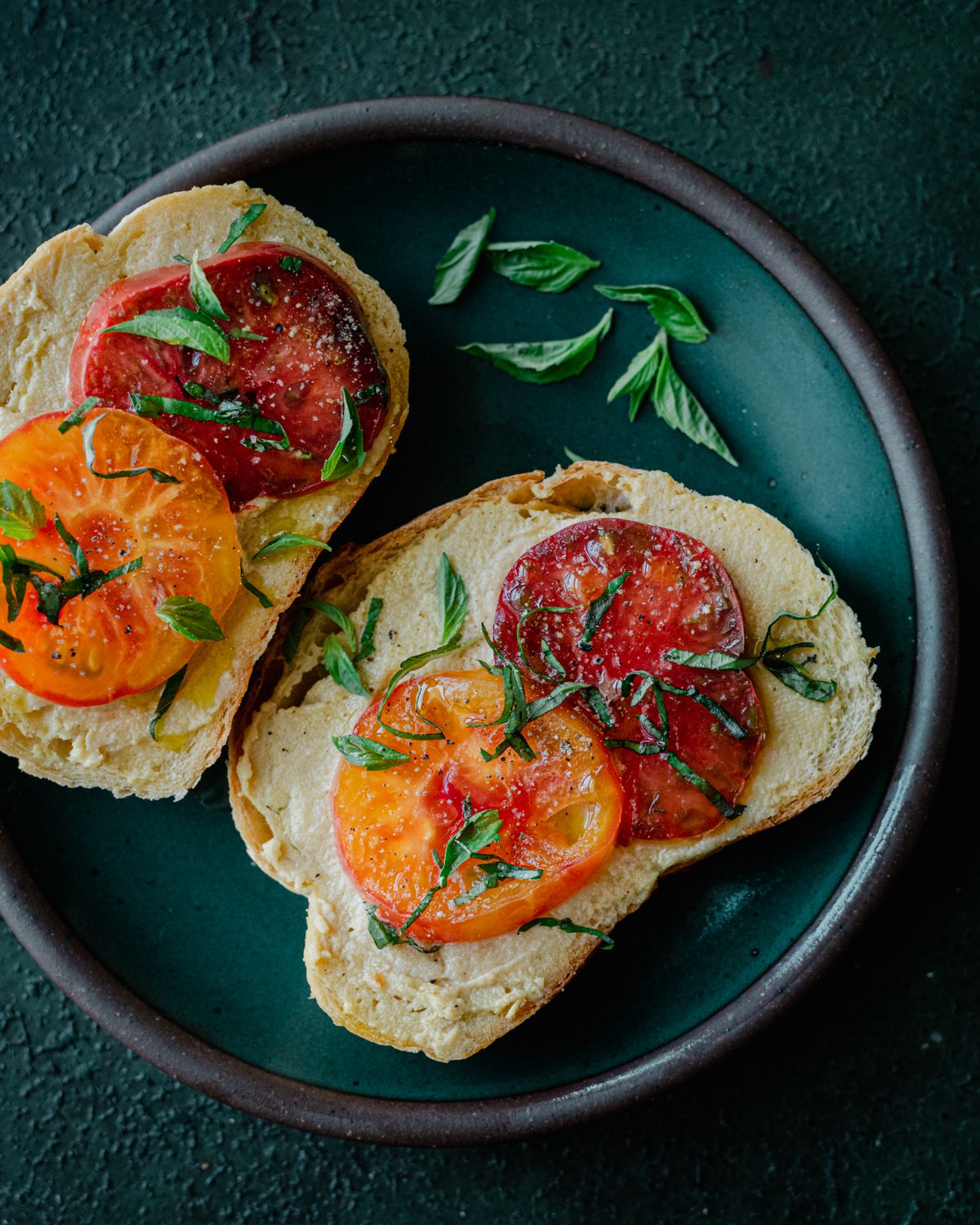
If you love this fermented cashew cheese, please leave a rating and review with your feedback and tag me on Instagram with your remakes :)

Big Vegan Flavor
Techniques and 150 recipes to master vegan cooking.
Fermented Cashew Cheese
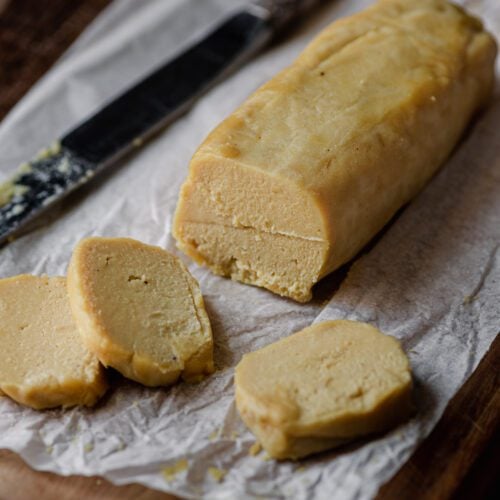
Ingredients
- 1 1/2 cups (200g) raw cashews, soaked in water overnight or for 8 hours or boiled in water on the stovetop for 15 minutes
- 2 tablespoons apple cider vinegar with the “mother”, shake the bottle to evenly distribute
- 1 tablespoon freshly squeezed lemon juice
- 3 tablespoons water
- 1/3 cup 67g refined coconut oil
- 1/2 cup ~25-30g nutritional yeast
- 3/4 teaspoon garlic powder (do NOT use fresh garlic!)*
- 3/4 teaspoon onion powder
- 1 1/4 teaspoons sea salt, more as needed
Instructions
- Drain the soaked cashews and rinse. Wash your glass jar and lid with warm soapy water and dry well.
- Add the cashews to a high-powered blender, along with the vinegar, lemon juice, water, and oil. Blend on medium or high speed, scraping down the sides as you go, until relatively smooth and creamy. Add the nutritional yeast, garlic powder, onion powder, and salt, and blend again until well incorporated and completely smooth. If you have a large blender container, like a 64 ounce jar, this will take several minutes, as you will need to scrape down several times, as there is very little liquid.
- Pour the mixture into a glass jar with an airtight lid. Seal and let the jar ferment in a warm place, for a minimum of 16 hours, or up to 48 hours.**If it’s summer, your kitchen counter works great. You can also place it in the oven with just the lightbulb on (be sure to not preheat your oven during this time and don't place it right next to the light, as it might get a little too warm). You can also ferment it outside if you live in a warm but temperate climate (no direct exposure to sun; loosely wrap the jars in a dish towel).
- Once the cheese has fermented, give it a stir and then refrigerate for at least 4 hours to firm up.
- Once the cheese has solidified, spoon half of it onto a sheet of parchment paper. Use a spoon to push it into a log-like shape. Roll up the parchment paper and use your hands and the parchment paper itself to mold and shape the cheese into a log shape. Repeat with the other half of the cheese in a second log. Refrigerate the cheese logs for 2 hours, or more, to set. Store leftovers wrapped in parchment paper in the refrigerator for at least 2 weeks.
Notes




What could I sub for coconut oil for please?
Hi Sarah, the reason we use coconut oil in this recipe is because it’s solid at room temperature. You can use another oil if you’d like, but it will never form into a block- it will stay like more of a cheese dip/spread.
I will definitely try this cheese. I just want you to know that I have tried at least 10 of your recipes are ready. They are all amazingly delicious! Thank you so much for what you do.
Amazing! Thanks for trying the recipes and letting us know :)
I have made it just now and even without fermenting it taste really nice. Can’t wait to see what it is like tomorrow evening. I have guests coming over next weekend and I was wondering how I could serve it. ? Like what would you put on top somit looks pretty. I would put it into a bowl and let ppl take it with a serving knife. What would taste good with it? Pistachios, cranberries??
Hi Petra, great to hear you are already loving the results! Fresh herbs would be a pretty addition, crunchy nuts on the exterior could also work well. This recipe is made with cashews so walnuts or cashews would probably work best around the outside! Serving the cheese with a side of different fruits could be lovely as well. We can see green apples being a great pairing. Hope some of that helped, and enjoy the time with your guests!
Hi,
This turned out great. I’m so glad I found your YouTube videos and this page. I wanted to ask about the nutritional info provided. Is it for the full dish or per serving?
Thanks!!
Thanks for sharing, JB! And the nutritional information is per serving.
I boiled the cashew, remove the water, blend everything and the paste is super liquid is it normal?
Hi Melanie, if you see the step-by-step instructions in the blog post it should be more of a paste consistency. We’re a bit confused because there isn’t much liquid that goes into this recipe so it shouldn’t be too liquidy! Did you make sure to measure all the ingredients exactly? The only liquid should be the apple cider vinegar and coconut oil.
My batter is going into fermentation and it tastes really good. As a newbie to Vegan food, I am looking for special things that lift my family. This is a winner. I don’t think there will be anyone who won’t enjoy it. Thank you, Nisha for your time and care and energy to share this with everyone!
Thanks for the lovely feedback, Mimi!
Well, finally completed my cheese. I taste-tested it myself and put some on bread, and if I live through the night, I’ll feed it to my family. 😂 I was so worried mine would rot instead of ferment and I’d poison everyone. LOL But it tastes and smells great, and I’m really just sad I didn’t double the recipe. My husband doesn’t like coconut, and it does have a bit of a coconut taste. I wonder if seasonings would mask it more, or if I could get away with using some kind of butter? I’ll experiment now that I know what I’m doing. Thanks for such a great recipe!
Good to hear the recipe turned out well for you, Jessie! We hope your family liked it. You could try adding in fresh garlic or more herbs/seasonings after fermenting right before you put it in the fridge.
And in regard to swapping out the coconut oil: you may be able to use margarine if it’s semi-solid at room temperature, but we haven’t tried it ourselves and are not entirely sure.
Did you use refined or unrefined coconut oil? Refined shouldn’t have a coconut flavor.
I don’t know if this is a stupid question, but I’m new to making vegan cheese, so overlook my ignorance. Just wondering, suppose I do this wrong… Am I gonna poison my family? I’m thinking if we’re talking fermentation, there’s little room for error and a fine line between fermenting and rotting. LOL Also wondering if I can just use bottled lemon juice? I’ve used it to make other cheeses and it’s been fine, but I’ve never made vegan cheese that required fermentation.
Hi Jessie, in the blog post we’ve included tips on fermentation titled “Where and how long to ferment the cheese.” If you follow those steps, there shouldn’t be a problem! And whatever you do, don’t expose the cheese to direct sunlight. There’s also a video on the blog post you can watch on it as well! Online it says “A spoiled ferment will smell rancid, like rotting broccoli. A good ferment will have a pleasant sour smell.” Also, bottled lemon juiced should work just fine! Enjoy :)
Thanks for the reply, and just in time! I panicked and just used my soaking cashews to make sour cream, but I’m trying it again today and I have it sitting on the counter right now. Fingers crossed! I read everything but I didn’t see the video. I’ll check it out.
Good luck, you’ve got this Jessie!
Utterly delicious, thank you so much!!!
Thanks for the lovely feedback, Cina!
A very pleasant, tasty cheese spread…easy to make. It gives me confidence to start try to make cheese again
Wonderful! Thanks for sharing, MarWee!
This is the most delicious vegan cheese I’ve ever had, and it’s so rewarding to know I’ve made it with my own hands from a few simple ingredients! Thank you so much for the great recipes, Nisha. Love the videos, it’s all golden!
Awesome, Sage. Thanks for your comment and for taking the time to review! :)
Thank you for sharing this recipe! I’ve made it twice now and absolutely love it. I used a liquid coconut oil the first time and the consistency remained like a spread. I used a solid refined coconut oil the second time and it firmed up so it could be sliced. Even my dogs beg for a taste of this cheese! One last comment/tip – definitely use sea salt – you can taste the difference.
Melanie, So glad to hear you loved this recipe!
Hello! This looks fabulous. I’ve really been trying to made more things at home (rather than buying, so as to avoid unnecessary packing). Quick question: Would the end product (the logs) freeze well? If so, how long do you believe they would keep? Again, many kind thanks for the inspo! Best, sadie :D
Can I make this cheese without using garlic and onion?
Hi Nguyen, yes you can but it won’t be nearly as flavorful that way.
Hi Nisha! I live in Georgia and it summer. Outside is hot (85-95 F), but inside we like it cool and keep the AC on 70F. Would it be better to ferment inside or outside?
Hi there Ashley, 85-95 may be too hot and ferment the cheese too quickly. Maybe you can put it in the oven with the light on instead?
Hey. Anu reason you use refined coconut oil? Can I use cold pressed virgin coconut oil?
Hi there Tia, we use refined coconut oil in this recipe because it has less of a distinct coconutty taste.
Hi i really want to make it but i cant find any apple cider vinegar where i live! Could i use regular vinegar?
From Nisha: “Hi Jen, sorry for the late reply! The reason I use apple cider vinegar is that it has good bacteria in it (it’s called “the mother”), and that’s needed to help ferment the cashew cheese mixture. Regular vinegar doesn’t contain that so it wouldn’t work. If you have access to vegan yogurt, you can use 3 tablespoons of that instead, it works great.”
I’ve just started making this recipe but because I had neither Garlic nor Onion powder I roasted some fresh garlic in the oven so it’s at least cooked, however because I was a bit worried I asked Dr Google and found out that even cooked onion/garlic can still foster growth of clostridium botulinum bacteria which is why I am reluctant to ferment it so I’ll just put it in the fridge and use it unfermented this time (will definitely try this additional process next time though).
I also replaced the salt with white miso paste and since this is a fermented product the taste of the mixture is absolutely amazing! Thank you so much for sharing this recipe and all your other recipes with the world. You’re one of the reasons why I went vegan. Much love from England <3
Hi bee, yes in the FAQ section we explain to not use fresh garlic in this recipe. We would suggest fermenting it, then adding in the finely minced garlic before placing the cheese into the fridge.
Thank you for the wonderful review and for sharing your experience. We are so happy to hear the RPL channel helped you go vegan!
Can the miso be added in this recipe during fermenting. I like a sharper cheese.
I have been removing All oils from my diet. Can this be made without oil.
Hi there Elsie, unfortuanately no. You can try making either our cashew queso or nut-free vegan cheese sauce though!
QUESTION????? Can I use granulated garlic instead of powdered??? Will it be okay to ferment for 16 plus hours? I’m on the east coast now
Hi Vicki, you wouldn’t get sick from using granulated garlic but it may add a bit of a grainy texture to the cashew cheese. We hope you get the chance to try it!